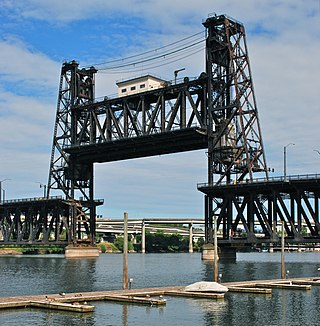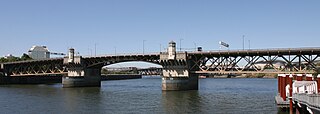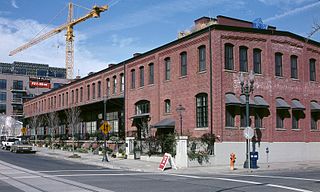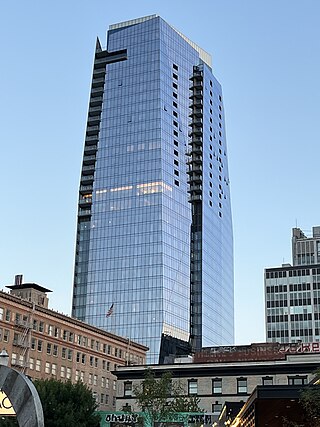
The Steel Bridge is a through truss, double-deck vertical-lift bridge across the Willamette River in Portland, Oregon, United States, opened in 1912. Its lower deck carries railroad and bicycle/pedestrian traffic, while the upper deck carries road traffic, and light rail (MAX), making the bridge one of the most multimodal in the world. It is the only double-deck bridge with independent lifts in the world and the second oldest vertical-lift bridge in North America, after the nearby Hawthorne Bridge. The bridge links the Rose Quarter and Lloyd District in the east to Old Town Chinatown neighborhood in the west.

The Oregonian is a daily newspaper based in Portland, Oregon, United States, owned by Advance Publications. It is the oldest continuously published newspaper on the U.S. West Coast, founded as a weekly by Thomas J. Dryer on December 4, 1850, and published daily since 1861. It is the largest newspaper in Oregon and the second largest in the Pacific Northwest by circulation. It is one of the few newspapers with a statewide focus in the United States. The Sunday edition is published under the title The Sunday Oregonian. The regular edition was published under the title The Morning Oregonian from 1861 until 1937.

The Burnside Bridge is a 1926-built bascule bridge that spans the Willamette River in Portland, Oregon, United States, carrying Burnside Street. It is the second bridge at the same site to carry that name. It was added to the National Register of Historic Places in November 2012.

The Marquam Bridge is a double-deck, steel-truss cantilever bridge that carries Interstate 5 traffic across the Willamette River from south of downtown Portland, Oregon, on the west side to the industrial area of inner Southeast on the east. It is the busiest bridge in Oregon, carrying 140,500 vehicles a day as of 2016. The upper deck carries northbound traffic; the lower deck carries southbound traffic. The Marquam also has on and off ramps for Interstate 405 on the south end of the bridge, while the terminus on the east bank of the river is near the interchange with Interstate 84.

Street Roots is a Portland, Oregon, United States–based homeless advocacy group and a weekly alternative newspaper that covers homeless issues. The newsprint is sold by and for the homeless in Portland. The paper is published every week and sold through vendors who are currently or formerly homeless. The paper's editorial position is homeless advocacy. Vendors purchase the paper for 25 cents and sell them for $1 and keep the difference of 75 cents. The paper features alternative news, interviews, and poetry written by local journalists as well as the homeless and those who work with them.

William Sumio Naito was an American businessman, civic leader and philanthropist in Portland, Oregon, U.S. He was an enthusiastic advocate for investment in downtown Portland, both private and public, and is widely credited for helping to reverse a decline in the area in the 1970s through acquiring and renovating derelict or aging buildings and encouraging others to invest in downtown and the central city.

The North Bank Depot Buildings, in central Portland, Oregon, United States, are a pair of buildings formerly used as a freight warehouse and passenger terminal for the Spokane, Portland and Seattle Railway (SP&S). Formed in 1905, the SP&S was commonly known as the North Bank Road during the period in which these buildings were in use. The Portland buildings' passenger facilities were also used by the Oregon Electric Railway after that railway was acquired by the SP&S. Located in what is now known as the Pearl District, the buildings were listed on the National Register of Historic Places in 1996. They were in use by the SP&S and its successor, Burlington Northern Railroad, from 1908 until the 1980s. Only the east building was used as a passenger station, and this usage lasted from 1908 until 1931.

Thompson Elk Fountain, also known as the David P. Thompson Fountain, David P. Thompson Monument, Elk Fountain, the Thompson Elk, or simply Elk, was a historic fountain and bronze sculpture by American artist Roland Hinton Perry. The fountain with its statue was donated to the city of Portland, Oregon, United States, in 1900 for display in Downtown Portland's Plaza Blocks. It was owned by the City of Portland.

The Women's March on Portland, also known as the Portland Women's March, the Women's March on Washington, Portland, and Women's March Portland, was an event in Portland, Oregon. Scheduled to coincide with the 2017 Women's March, it was held on January 21, 2017, the day after the inauguration of Donald Trump. The march was one of the largest public protests in Oregon's history with crowd estimates as high as 100,000 participants. No arrests were made during the demonstration.

Alexis Restaurant was a Greek restaurant in Portland, Oregon's Old Town Chinatown neighborhood, in the United States. It was established in 1981 and closed on November 7, 2016.

Swank and Swine is the collective name of the former restaurant Swank and the bar Swine, located in Portland, Oregon's Paramount Hotel, in the United States. Swank was rebranded as Taylor Street Tavern in 2022.

Block 216 is a high-rise building in downtown Portland, Oregon, United States. The 35-story building replaced the Alder Street food cart pod and parking lot between 9th and 10th avenues and Alder and Washington streets. At 460 feet (140 m) tall, it is Portland's fifth-tallest structure. Block 216 houses the Ritz-Carlton, Portland, a food hall, and other retailers.

The COVID-19 pandemic was confirmed to have reached Portland in the U.S. state of Oregon on February 28, 2020.

Hotel Rose, sometimes referred to as Staypineapple at Hotel Rose, is a 140-room boutique hotel in southwest Portland, Oregon, United States. Located in downtown Portland across from Tom McCall Waterfront Park, the hotel opened as Riverside West Motor Hotel in 1964 and later operated as a Four Points by Sheraton property and as Hotel Fifty.

Dossier is a multi-floor hotel at 750 Southwest Alder Street in downtown Portland, Oregon.
Henry Thiele Restaurant, or Henry Thiele's, was a restaurant located at 2315 Northwest Westover Road in Portland, Oregon.

The AC Hotel Portland Downtown is a 204-room hotel operated by Marriott International in Portland, Oregon. Located at the intersection of Southwest 3rd Avenue and Taylor Street, the 13-floor hotel opened in 2017.

Cart Blocks is a food cart pod in Portland, Oregon's Ankeny Square, in the United States. It is operated by Friends of the Green Loop.

Yaw's Top Notch was a restaurant in Portland, Oregon.

Cassidy's Restaurant and Bar, or simply Cassidy's, is a restaurant in Portland, Oregon.




















